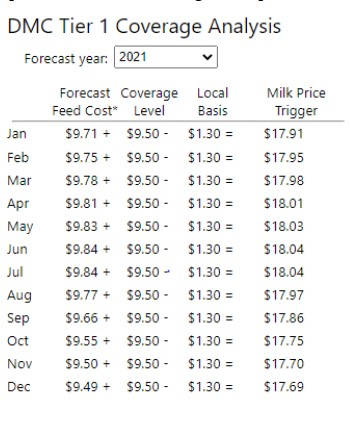By Megan Roberts and Nathan Hulinsky
As 2020 draws to a close, many dairy farmers are looking ahead to 2021. For farmers in the process of renewing operating loans, now is the time to reflect on milk pricing lessons learned in 2020 as you prepare to meet with your lender regarding 2021.
- Communicate early and often with your lender
- Provide accurate information on your farm’s participation in risk management
- Remember 2020 showed unexpected events can rattle cash flows
Communicate early and often with your lender
This suggestion may seem too obvious, but no one likes surprises, especially ag lenders. Be proactive in preparing for your winter lending meeting. Update your financial statements with enough advance time to critically evaluate each statement. What went right financially in 2020 and what went wrong? What questions and concerns do you anticipate from your lender? Keeping communication lines open with your lender allows you to recognize potential financial concerns early.
Provide accurate information on your farm’s participation in risk management
If your farm has utilized programs such as Dairy Margin Coverage (DMC), providing accurate information on your participation level can help show your lender best case and worst case cash flow scenarios. Depending on farm size and coverage level, your farm could have up to 95% of your annual historic protection protected with DMC. With many farms selecting Tier 1 (up to 5,000,000 annual lbs) coverage at the $9.50/cwt margin, the DMC program can be an effective talking point when discussing next year’s cash flows and how risk management tools can reduce the financial impact of unexpected milk prices or feed costs.The Programs on Dairy Markets & Policy’s (DMaP) Dairy Margin Coverage (DMC) tool enables you to create producer specific graphs showing your coverage level and projected monthly price triggers. If you participate in other risk management programs through your crop insurance agent, such Dairy Revenue Protection (DRP) or Livestock Gross Margin for Dairy Cattle Insurance (LGM-Dairy), these are also key in discussing your 2021 cash flow sensitivity.
Remember 2020 showed unexpected events can rattle cash flows
You cannot predict unexpected events, but you can show your lender how programs like DMC can protect your farm’s cash flow when actual prices vary from forecasted models. 2020 is a prime example of what Black Swan events can do to markets and cash flow projections. Milk futures at the end of 2019 were looking fairly optimistic, but with the COVID pandemic and closures of restaurants and schools, milk prices plummeted in March, April and May while feed cost remained fairly stagnant. DMC triggered payments in March, April, May, and September 2020.The pandemic highlighted the importance of a risk management plan.

Figure 1 DMC Tool with Local Basis Analysis
Let’s walk through an example using the coverage tool. In our example, a hypothetical farm had annual historic production of exactly 5,000,000 lbs and they selected 95%, $9.50 coverage level for 2021 for a sunk cost total annual premium of $7,125. In 2021, 47,500 cwt of their milk is protected against any margin below $9.50/cwt. Using forecasted feed prices* and taking into account that local milk prices historically trend lower than the national all milk price, the coverage analysis tool shows projected 2021 monthly milk price triggers for DMC payments for local milk prices between $17.69 to $18.04 (see Figure 1). Historically, -1.30/cwt has been an average basis for Class III milk price (the most common in Minnesota) as compared to the all milk national price, so this historical number was entered into the local basis box for our example. However, it is important to note that during 2020, Class III milk basis in Minnesota has not trended negative; therefore using the local basis adjustment tool may not fit current pricing dynamics. At current prices, our example farm would not expect DMC payments given both the all milk price and basis adjusted local price are hovering above the trigger. Feed price changes or milk price swings could certainly change this scenario.
If you are curious about how to use the Programs on Dairy Markets & Policy’s (DMaP) Dairy Margin Coverage (DMC) tool please visit their website. The sixteen minute shows how to tailor the web tool to fit your farm size, coverage level, and expected local prices. Use the “Coverage Analysis” tab to enter your farm specific information to get projected coverage. If desired, you can enter in the “local basis” box your predicted difference between your monthly mailbox price/cwt and the all milk national price.
*Feed prices were calculated at the time of writing by the DMC tool using futures market projections dated 12/8/20. At the time projected per cwt feed costs for 2021 ranged from a low of $9.49/cwt in November 2021 to a high of $9.84/cwt in June and July 2021. Projections are simply forecasts, and real time data often varies from futures market predictions.
Source : umn.edu